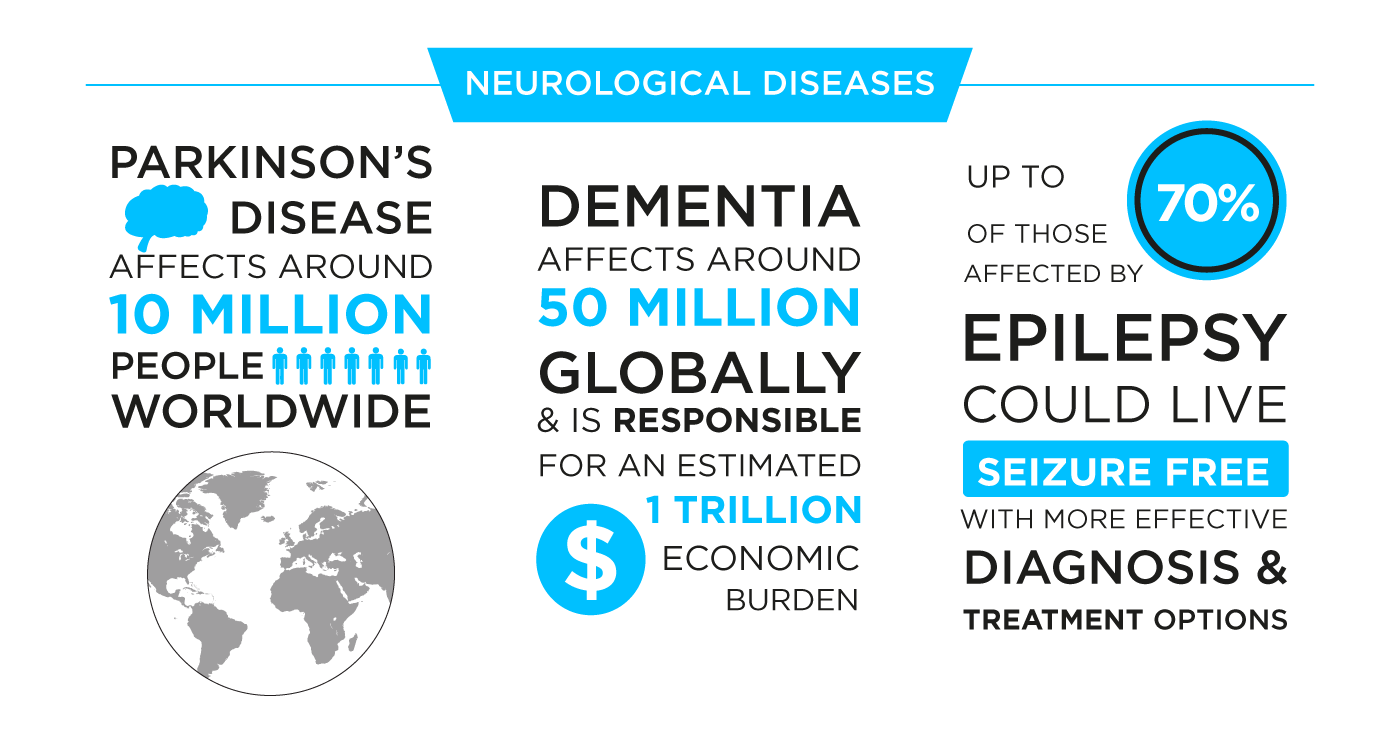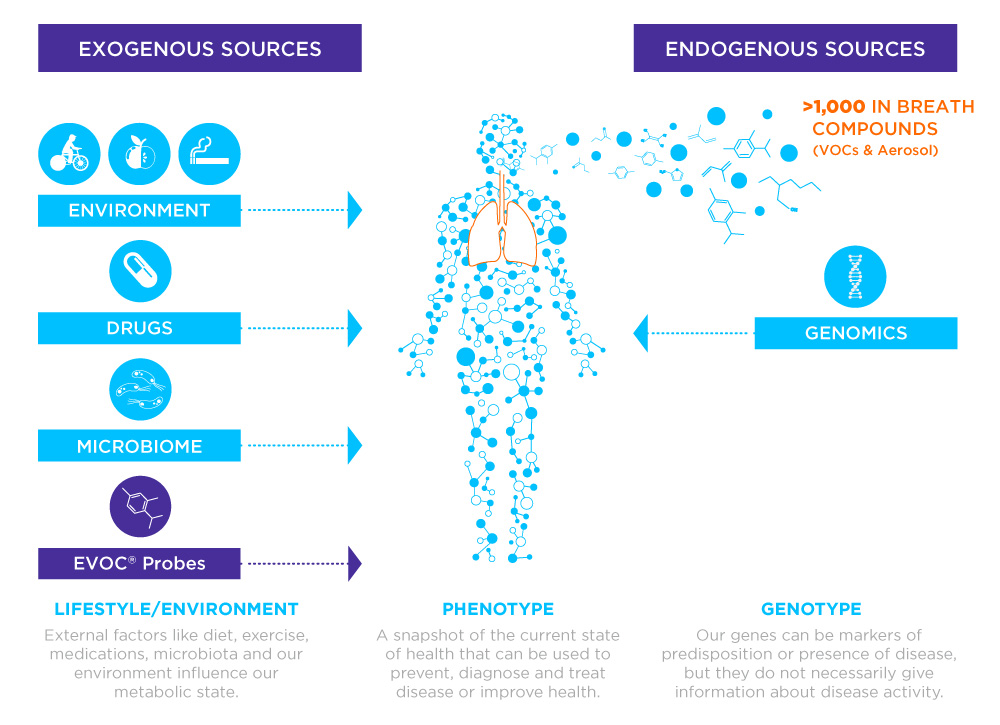Applying Breath Biopsy® to neurological diseases
Published on: 6 Oct 2020
Diagnosing neurological disorders is extremely challenging
Neurological disorders are the leading cause of disability and the second largest cause of death worldwide1. Dementia alone, affects around 50 million people globally and is responsible for an estimated $1 trillion economic burden, with epilepsy affecting a similar number of people.
 Historically, diagnosis of neurological disorders was nearly impossible. Just a century ago, the only way to make a definitive diagnosis was to perform an autopsy after the patient’s death2. We’ve come a long way but diagnosis today is still time-consuming and inaccurate in many cases. At present, to diagnose dementia, doctors rely on physical symptoms and a combination of invasive, and often extensive, procedures for biomarker testing including blood tests, brain MRI, and CT scans.
Historically, diagnosis of neurological disorders was nearly impossible. Just a century ago, the only way to make a definitive diagnosis was to perform an autopsy after the patient’s death2. We’ve come a long way but diagnosis today is still time-consuming and inaccurate in many cases. At present, to diagnose dementia, doctors rely on physical symptoms and a combination of invasive, and often extensive, procedures for biomarker testing including blood tests, brain MRI, and CT scans.
Diagnosis is similarly challenging for Parkinson’s disease, another neurological disorder that currently affects more than 10 million people worldwide3. Again, there is no specific diagnostic test available and instead, treatment is often used to diagnose suspected patients. If administration of carbidopa-levodopa (Rytary, Sinemet, others), a Parkinson’s disease medication, leads to a significant reduction in symptoms then a diagnosis of Parkinson’s disease is confirmed.
Achieving accurate and early diagnosis of neurological diseases would have huge benefits for millions of patients and carers4. While there is presently no cure for neurological disorders, correct treatment can significantly reduce the symptoms, delay disease progression and increase the patient’s quality of life5. For instance, it is estimated that up to 70% of those affected by epilepsy could live seizure-free with more effective diagnosis and treatment options6.
Across all neurological disorders, earlier diagnosis would unlock less expensive treatment pathways, saving on healthcare spending.
Breath biomarkers for neurological diseases
Biomarkers are transforming our understanding of disease. One source of biomarkers is the volatile organic compounds (VOCs) in our breath. Originating from either within the body or external sources, they provide a rich source of information regarding overall health and have great potential as indicators of both disease onset and progression. Therefore identification of biomarkers from breath samples for specific neurological diseases would not only aid diagnosis, but could also support drug trials with patient enrollment and efficacy monitoring.
Breath Biopsy has many qualities that set it apart from other sampling methods, including the fact that it is both non-invasive and inherently risk-free. It is possible to increase the sensitivity of a breath test simply by extending sampling time to pre-concentrate VOCs. As we breathe, the VOCs on breath can originate from any part of the body, this means that a breath is a ‘whole-body sample’ with the potential to diagnose neurological disorders, as part of a screening program, even before symptoms arise.
All of these factors together mean that Breath Biopsy is ideal for use with at-risk groups, even as part of longitudinal studies, and therefore uniquely suited to the analysis of neurodegenerative disease, both for diagnostics and also ongoing monitoring of treatment response.
To date, research into the use of breath analysis for the diagnosis of neurological diseases has been limited but several recent studies are outlined in the table below:
Perhaps the most significant of these papers is the study by Tiele et al. on ‘Breath-based non-invasive diagnosis of Alzheimer’s disease’7. This study of 100 subjects, half of which were healthy, used gas chromatography ion mobility spectrometry (GC-IMS) on breath samples, to successfully separate diagnostic groups with 68% sensitivity and 80% specificity. Their results indicated that six VOCs were potential biomarkers for Alzheimer’s disease detection and progression, with hexanal produced via lipid peroxidation of particular interest. You can read more about the potential value of the metabolic process of lipid peroxidation to the progress of breath-based research in one of our previous blog posts.
We’re here to help
As the global leaders in Breath Biopsy, we’re equipped to help you at every stage of your research into neurological disease biomarkers.
- Using an advanced analysis platform built on Breath Biopsy sample collection and high-resolution GC-MS detection we can support simultaneous high-resolution targeted and untargeted biomarker investigation, to suit your needs.
- Thanks to our role in some of the world’s largest breath research trials, our team includes experts on study design and planning.
- Beyond biomarker discovery and validation, we can work with you to develop identified biomarkers into focused breath-based tests for clinical implementation.
References
- GBD 2015 Neurological Disorders Collaborator Group (2017) Global, regional, and national burden of neurological disorders during 1990-2015: a systematic analysis for the Global Burden of Disease Study 2015. The Lancet Neurology 16(11): 877-897. https://doi.org/10.1016/S1474-4422(17)30299-5
- National Institute of Neurological Disorders and Stroke (2020) Neurological Diagnostic Tests and Procedures Fact Sheet. https://www.ninds.nih.gov/Disorders/Patient-Caregiver-Education/Fact-Sheets/Neurological-Diagnostic-Tests-and-Procedures-Fact
- Parkinson’s Foundation, Understanding Parkinson’s Disease statistics. Accessed September 2020. https://www.parkinson.org/Understanding-Parkinsons/Statistics
- NHS UK, Dementia diagnosis guide. Accessed September 2020. https://www.nhs.uk/conditions/dementia/diagnosis/
- Batista and Pereira (2015) Quality of Life in Patients with Neurodegenerative Diseases. Journal of Neurology and Neuroscience. https://www.jneuro.com/neurology-neuroscience/quality-of-life-in-patients-with-neurodegenerative-diseases.php?aid=8682
- World Health Organization, Epilepsy Fact Sheet. Accessed September 2020. https://www.who.int/news-room/fact-sheets/detail/epilepsy
- Tiele et al. (2020) Breath-based non-invasive diagnosis of Alzheimer’s disease: a pilot study. J. Breath Res. 14 026003 DOI: 10.1088/1752-7163/ab6016
- Tisch et al. (2013) Detection of Alzheimer’s and Parkinson’s disease from exhaled breath using nanomaterial-based sensors. Nanomed. 8(1) 43-56 (2013) DOI:10.2217/nnm.12.105
- Tisch et al. (2012) Detection of asymptomatic nigrostriatal dopaminergic lesion in rats by exhaled air analysis using cardbon nanotube sensors. ACS Chem. Neurosci. 3(3) 161-166 (2012) DOI:10.1021/cn200093r
- Broza et al. (2017) Exhaled Breath Markers for Nonimaging and Noninvasive Measures for Detection of Multiple Sclerosis. ACS Chem. Neurosci. 8(11) 2402-2413 DOI: 10.1021/acschemneuro.7b00181

